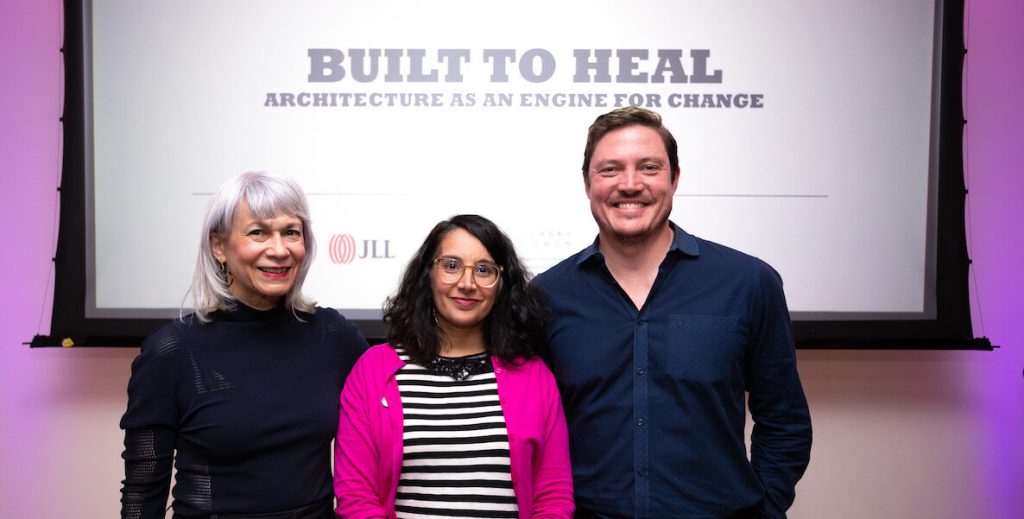Architect Michael Murphy, founder of MASS Design Group, drew a crowd of 125 to the Fitler Club on December 14. For a little over an hour, Murphy and Inga Saffron, Pulitzer Prize-winning architecture critic for The Philadelphia Inquirer, talked about architecture’s role in healing and community. The conversation was part of The Philadelphia Citizen’s Development … for Good event series, in partnership with the Drexel University Lindy Institute for Urban Innovation and the Fitler Club.
Murphy’s firm — MASS stands for “Model of Architecture Serving Society” — has designed buildings that heal in the literal sense. He’s well known for his collaboration with Dr. Paul Farmer of Partners in Health on the handsome, fresh air-filled Butaro District Hospital in Rwanda, and the strikingly modern Cholera Treatment Center in Port-au-Prince, Haiti, “with its diamond-shaped pavilions and screens that allow air to pass through that also grow at night” said Saffron.
But he’s also behind the non-medical design of Montgomery, Alabama’s National Memorial for Peace and Justice, an incredibly moving monument to the historic violence inflicted upon and endured by African Americans. The memorial heals in a different way. The site does this so effectively that, in its less than five years (including pandemic years), it has attracted 2 billion visitors and brought a whole new level of tourism to the city.
Healing, by design
The idea behind Murphy’s work: Buildings people use — especially spaces where humans are at their most vulnerable — should impart “a sense of dignity, a sense of citizenship, a sense of rights, a sense of beauty, and a sense of comfort,” he said.
“Hospitality and hotel come from the same root. And yet, a hotel of luxury and comfort looks very different from a hospital room,” he said. “What we smell, what we see, what we hear, what we feel — these are the things that we designers think about. A lot of that gets pulled out of a sterile environment like a hospital when the primary motivation is sanitation and cleaning, and functioning and turnover.”
The challenge, then, is to meet dual goals of function and feeling — while also focusing on economic and environmental sustainability.
Not a small challenge, but one where Murphy has excelled. For the hospital in Rwanda, Murphy’s team employed local workers, including women, to hand-cut and assemble unwanted local stone into beautiful walls. This solution was not just more fruitful for the workers, beautiful to the viewer, healthier for the environment, or dignified for the patients. It was also more affordable.
For the memorial in Montgomery, builders poured concrete into forms made of pine rescued from 19th century Alabama barns cited on old cotton plantations.
Buildings, says Murphy, all tell stories: “You walk down Philadelphia streets, and you can talk about where these bricks were made in the foundries on the river. We can talk about the unique labor that was imported to do a certain type of masonry work. There’s a narrative about people and culture within every structure. We need to elevate that.”
Slow … architecture
The architect compares his approach to that of the slow food movement. The idea: All steps in the process are thoroughly considered.
The answers, Murphy seems to say, are all around us. They are the people in the communities looking for work, the beautiful and overlooked local materials, the community members who contribute to their neighborhood organization.
“It begins not just at the design of the building, but at the design of the system that’s going to fund that building,” he said. Murphy believes in design equity: Architecture is not a luxury; it’s a long-term essential.
“The argument is not to say How can we afford to do that? It’s to say, How can we afford not to do that?” he said. “That was Paul [Farmer’s] question. ‘How can you afford not to have architecture?’”
Murphy’s is a “push not just for more beautiful things, but a push for a change in our policy, a change in our dialog about what we deserve as individual citizens.”
VIDEO OF DEVELOPMENT FOR GOOD: BUILT TO HEAL WITH MICHAEL MURPHY
PHOTOS FROM THE EVENING
Thank you to our generous Development … for Good sponsors:
MORE ON DESIGN FROM THE PHILADELPHIA CITIZEN

